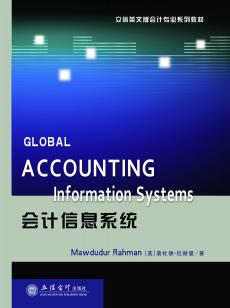| |||||||||||||||||||||||||||
| 友情链接: | 上海立信会计金融学院 | 立信会计用品有限公司网店 | 京东网店 | 天猫网店 | 内网系统 |
| |||||||||||||||||||||||||
商品描述 | 包装清单 | 保修条款 |
This book provides an introduction to accounting information from the accountant's perspective.In my search for AIS text book to use in undergraduate and graduate courses to teach students across different countries,I discovered a number of excellent books on the subject those emphasize computerized information systems and use accounting applications liberally.These texts are more appropriate for a course in systems analysis than for accounting.It is sometime difficult to use these books indifferent cultures given specific examples from one culture only.
This textbook is designed to assist students in understanding the rationales for developing different forms and types of accounting information;the relationships between and among accounting departments,information services departments,operating departments,and staff agencies of private and public sector organizations;and the several support modes available via emerging computer technologies,along with their capabilities,limitations,and liabilities.It incorporates examples and applications from different cultures.
The book is divided into four parts.
Part I consists of three introductory chapters.Chapter 1 covers the uses of accounting information. This chapter is particularly useful in broadening the perspective of undergraduate students beginning accounting students tend to compartmentalize learning according to the content of courses offered in the different branches of accounting.Chapter 2 provides an overview of the systems approach to analyzing organizations.We find that the systems view clearly represents both the static and dynamic elements of organizations.Chapter 2 uses systems concepts to define the AIS,to provide a distinction between the AIS and its computerized components,and to examine those environmental factors that facilitate AIS SUCCESS or constrain its development.Chapter 3 briefly reviews basic accounting principles.We have found this to be especially useful for our in-service MBA students,who have relatively weak accounting preparation or who have been aw,ay from academia for some time.It is not intended to be a comprehensive accounting review but rather emphasizes fundamentals The chapter establishes the basic procedures followed in a manual accounting system and iIlustrates how these are accomplished via automated procedures available to large and small organizations.
Part II identifies and discusses the essential components of AIS and the interfaces among them This section focuses on the static features of the AIS.Chapter 4 deals with the primacy of the accountant in the human-machine relationship.Chapter 5 provides an overview of the hardware available to support accounting requirements.Chapter 6 reviews the levels of software and the generation of software that activates the hardware.Chapter 7 investigates the capabilities and l imitations of different data storage configurations.
Part III turns to the more dynamic aspects of the AIS.Chapter 8 considers the relative merits of batch and on-line processing techniques.This is the dynamic of the AIS in the short run-the use of existing capabilities.Chapters 9 and 10 outline the alternatives open to the accountant faced with the need to acquire additional capabilities,given the reality that accounting information requirements change over time.Chapter 9 describes the traditional application development life cycle.Chapter 10 is devoted to more innovative methods of developing or procuring the necessary software for accounting support.
Part IV deals with the practical day-to—day considerations in using AIS to support the needs of management.This section provides an in-depth understanding of the roles of the AIS supporting management’s requirements and objectives at all levels in the organizational hierarchy.The issue of control is emphasized throughout these chapters.Chapter 1 1 describes control perspectives in an organization and deals with different operating control frameworks.Chapter 12is devoted internal controls in accounting,to highlighting the Chapter 1 3 introduces AIS role in management contr01.Chapter 14 incorporates new materials to the AIS subject areas and provide guidance for future directions.Chapter 1 5 is devoted to the current issues in AIS.



















